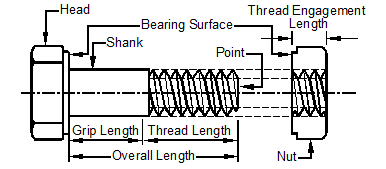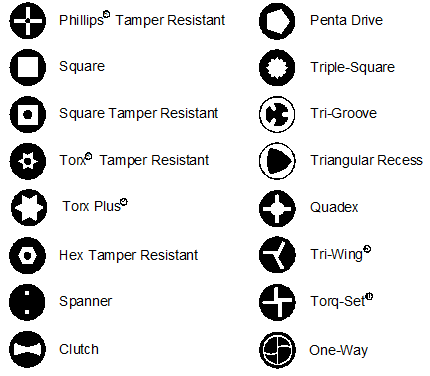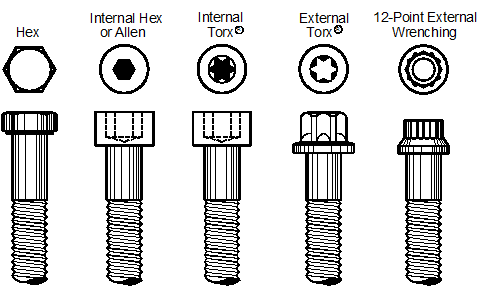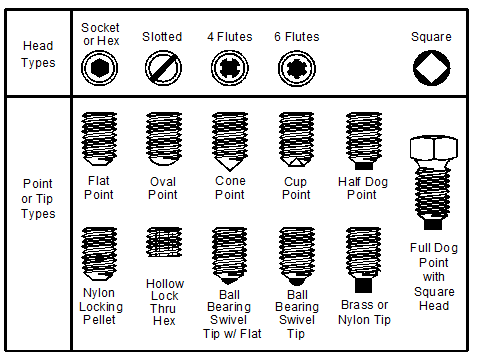- Acknowledgements
- Introduction
- Chapter 1: Measurement Tools, Layout & Job Planning
- Chapter 2: Basic Hand Tools
- Chapter 3: Filing & Sawing
- Chapter 4: Grinding, Reaming, Broaching & Lapping
- Chapter 5: Drills & Drilling Operations
- Chapter 6: Threads & Threading
- Chapter 7: Turning Operations
- Chapter 8: Milling Operations
- Chapter 9: Fastening Methods
- Chapter 10: Why Steel Hardens
- Chapter 11: Safety & Good Shop Practices
- Chapter 12: Other Shop Know-how
- Appendix I: Sharpening Steel Lathe Tools
- Appendix II: Surface Speed Table & Cutting Tool Selector Chart
- Appendix III: Decimal Equivalents of Fractional, Letter & Metric Drills
- Glossary
- Index
Chapter 9
Fastening Methods
The man who makes no mistakes does not usually make anything.
—Edward John Phelps
Introduction
Most machine shop time is spent turning raw materials into finished parts, but the next manufacturing step is often assembling and fastening these parts together. This chapter looks at both fastening devices: screws, bolts, pins and rivets, and fastening processes: adhesive bonding, soldering, and welding. Cost, weight, strength, availability, reliability, corrosion resistance and simplicity are some of the many factors that influence the fastening method used by the prototype or non-production machinists. There are over one hundred different fastener designs and tens of thousands of variations when size, finish and material are counted. This chapter presents the most common fastening methods. Information on other methods can be obtained from Machinery’s Handbook, industrial tool supply catalogs and manufacturers’ product literature. These sources often include excellent application notes.
Section I – Threaded Fasteners
Parts of a Bolt
What are the parts of a bolt?
See Figure 9–1.

Screws vs. Bolts
What are the differences between screws and bolts?
- Screws are externally threaded fasteners capable of being inserted into holes in assembled parts, of mating with a preformed internal thread, of forming their own thread, and of being released by torquing their heads.
- Bolts are externally threaded fasteners designed for insertion through holes in assembled parts, and are normally intended to be tightened or released by torquing a nut.
These definitions are from ANSI-ASME B18.2.1 1981 and Fastener Standards, 6th Edition, International Fastener Institute, Independence, OH 44131 and are recognized by the U.S. Government.
What is the difference between drive design and head design?
Drive design is the external or internal shape on the fastener head that couples the screwdriver, socket wrench, or other driving tool to turn the fastener. The head design is the overall shape of the head that makes the fastener better suited to a particular application such as a round, flat, oval, or fillister head. However, there is some overlap: all external hex drives are hex heads, but internal hex drives, also called Allen heads, may take a variety of shapes. Even though they are commonly called hex or Allen heads, these two terms are imprecise.
Screw Drive Designs
What are the most common drive designs for screws?
The most common designs are shown in Figure 9–2:
- Slot heads have a single slot and are driven by a flat-bladed screwdriver. Their main drawback is that they do not work well with power screwdrivers since flat blades have a tendency to come out of the slot and damage surrounding work. Slot heads are used on screws and small bolts.
- Phillips heads, sometimes called cross-head screws, have a "+"-shaped slot. They were originally designed for use with power screwdrivers in production. The rounded corners in the tool recess make the driver cam out when the fastener is tight, and also makes unscrewing difficult. Phillips heads are used on screws and bolts.

Figure 9–2. Common screw and bolt drive designs.
- Combo heads accept either a Phillips screwdriver or slot-blade driver. The National Electric Code now requires this head on all wiring devices, switches, outlets, and the like. Combo heads are only used on screws.
- Pozidriv® heads are similar to Phillips heads, but have more metal-to-metal contact to permit higher torque application without camming out. Phillips screwdrivers will usually work in Pozidriv screws, but Pozidriv screwdrivers are likely to slip or tear out the screw head when used in Phillips screws. Popular in Europe, Pozidriv is used on screws and bolts and may be identified by the four small lines at 45° to the main cross. It is a growing practice to put Phillips heads on inch-based fasteners and Pozidriv heads on metric ones.
Phillips, Pozidriv, Bureau de Normalisation de l'Aéronautique et de l'Espace (often marked B.N.A.E.), and Supadriv® drives appear nearly identical as viewed from above, but they require their own matching bits because their internal cavity shapes differ.
What are some other screw drive designs?
See Figure 9–3. These designs are usually chosen for their use with power drivers, and for their tamper resistance.

Figure 9–3. Other screw drive designs.
Bolt Drive Designs
Although some bolts are slotted or Phillips, heavy-duty, industrial, and aerospace bolts often have one of the following drive designs:
- External hex drive is the most common design for bolts. They work with socket wrenches, box wrenches, and open-end wrenches. These bolts are also called hex head bolts.
- Internal hex or Allen drive have a hexagonal hole and are driven by a hexagonal wrench, sometimes called an Allen key, or by a power tool with a hexagonal bit. Allen heads are used on screws and bolts.
- Internal Torx® drive is star-shaped with six rounded internal points. This design works well with power screwdrivers, permits the application of high torque without camming out, and resists tampering. Torx heads are used on all sizes of screws and bolts.
- External Torx drive is the male version of the internal Torx fastener.
- 12-point external wrenching drive for high-strength bolts.
All these designs work well with power drives and have much higher torque transmission than with a slot or Phillips head. See Figure 9–4.

Figure 9–4. The most common bolt drive designs.
Important Threaded Fasteners
What are the main threaded fasteners?
Machine screws, Figure 9–5, are made in a variety of head shapes, drive styles, and materials. They are available as small as #0000 (0.021-inches diameter) to ½-inch diameter and in lengths from ⅛ to 3 inches.

Figure 9–5. Machine screw head shapes.
- Machine bolts, Figure 9–6, are most often available in hex or square head in diameters from ½ to 3 inches. Mating nuts are available for them. Dimensional control on machine bolts makes them suitable only for rough work.

Figure 9–6. Machine bolts.
- Socket head cap screws and bolts are similar to machine screws and machine bolts, but of higher quality. They usually have a distinctive cylindrical head, a semi-finished bearing surface under their heads, and are made to higher dimensional standards. They are heat treated, making them substantially stronger than machine screws and bolts of the same diameter, and are available from #0 through 2-inches diameter and from ¼ to 10 inches in length. Although they come in several different lengths within a given diameter, their minimum and maximum lengths are proportional to their diameters. Both inch and metric sizes are available. Cap screws with drives other than hex and Phillips head shapes are available; some are shown in Figure 9–4. They are most commonly available with a black oxide finish, but stainless steel is available. Socket head cap screws are the most readily available quality fastener because most industrial tool supply companies and heavy equipment dealers stock them. Even higher quality fasteners can be obtained, but only through fastener specialty houses and at substantial additional cost.
- Set screws, Figure 9–7, are threaded fasteners that hold pulleys and collars on shafts. They also lock and hold mechanical settings or adjustments in place and come in more than a dozen basic shapes. They are usually heat-treated steel, but are also available in stainless, nylon, and Delrin®. Inch-based sizes follow the pattern used for screws and bolts: numbered sizes, #0 through #12, and then fractional-inch sizes. See Machinery’s Handbook.

Figure 9–7. Set screw designs. Cup point is the most common set screw and often used to secure gears and pulleys onto shafts. The sharp edge of its rim digs into the shaft metal anchoring the gear or pulley to its shaft.
- Carriage bolts, Figure 9–8, are used to join heavy lumber. A square shank section just under the head that is larger than the shank diameter keeps the bolt from turning as its nut is tightened.

